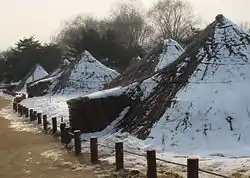Amsa-dong
Amsa-dong is a dong (neighbourhood) of Gangdong-gu in Seoul, South Korea.[1][2] The dong is well known for the Amsa-dong Prehistoric Settlement Site, in which Neolithic remains were excavated after a large amount of diagonal-line patterned earthenware was exposed by a flood in 1925.[3][4]
Amsa-dong | |
|---|---|
| Korean transcription(s) | |
| • Hangul | 암사동 |
| • Hanja | 岩寺洞 |
| • Revised Romanization | Amsa-dong |
| • McCune–Reischauer | Amsa-tong |
 Amsa-dong Prehistoric Settlement Site | |
| Country | South Korea |
| Area | |
| • Total | 4.7 km2 (1.8 sq mi) |
| Population (2001)[1] | |
| • Total | 73,377 |
| • Density | 15,612/km2 (40,430/sq mi) |
References
- "암사동 (Amsa-dong 岩寺洞)" (in Korean). Doosan Encyclopedia. Retrieved 2008-04-18.
- "The origin of Amsa-dong" (in Korean). Gangdong-gu official site. Retrieved 2008-04-18.
- "Amsa-dong Prehistoric Settlement Site". Korea Tourism Organization.
- "Historical Attraction". KTDC. Archived from the original on 17 April 2008. Retrieved 2008-04-18.
External links
- Gangdong-gu map at the Gangdong-gu official website
- (in Korean) The Amsa 1 & 4 dong Resident office
This article is issued from Wikipedia. The text is licensed under Creative Commons - Attribution - Sharealike. Additional terms may apply for the media files.
